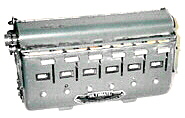|
|
|
 |
 |
|
|
 |
 |
 |
| After
more than seven years with Hants & Dorset,
Southampton Corporation was a culture shock.
On Hants & Dorset the conductor had been
in charge of the bus. In particular the conductor
was responsible for time keeping and it was
possible to go several days without seeing
an inspector on the road. The Corporation
put drivers in charge and had inspectors and
regulators to make all the important decisions.
The inspectors and regulators did not seem
to be there to assist the crews, the relationship
was more confrontational than I had been used
to. |
 |
| We had our share of rough
drivers on H&D but here there seemed to
be a rule that conductors must be bruised.
I worked with one driver who would leave late
so that he could drive flat out. One kept
his foot on the clutch pedal all the time
giving a rough ride, another hit the kerb
on almost every corner. Another driver never
took a tea break. He drove so slowly that
I was always busy while the next bus followed
almost empty. So I didn't get tea breaks either.
The co-operation which was normal on the old
company seemed to be completely missing here.
|
 |
| One reason for this may
have been the fact that new drivers and conductors
did not go on the rota but were given work
one day at a time. It could take months before
a vacancy arose. Once on the rota a crew,
whether they got on or not, stayed together
until one left or the conductor became a driver
or the driver went on the one-man routes.
Even on the rota there was a difference, the
week was made up of a different duty every
day. |
 |

|
 |
| The ticket
machine was different too, the
Ultimate. This machine took pre-printed
rolls of tickets, each a different
colour and with a different value. |
 |
| Some fares
required a double ticket. To print
this you had to press the button
under the counter as you flicked
the lever to issue the ticket.
This way the fare stage only printed
on one of the tickets and a double
ticket could be distinguished
from two individuals. |
|
|
 |
|
 |
|